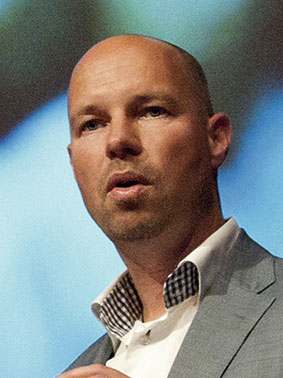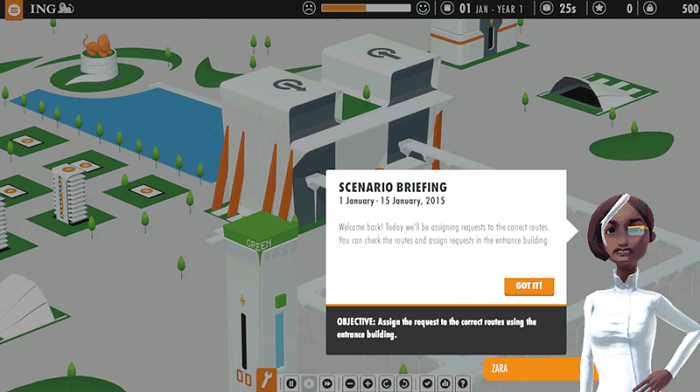
The ability to play games will be a crucial part of the future skillset of C-level. In 2015 a typical young American has spent around 10,000 hours playing computer and video games by the age of 21. As writer Malcolm Gladwell has famously suggested, people who practice a skill for 10,000 hours by that age are likely to become expert at it. The current “game generation” will be our future leaders. With the growing amount of information and the need for constant change, there will be a desperate need in reinventing the current human-machine interaction. Applying game technology in a business setting is key in the near future. We are talking with Jan de Boer, partner with KPMG and head of the KPMG Dutch Game Desk.
Gamification is no fad. Within ten years, it will play as crucial a role in transforming internal processes, consumer behavior and business outcomes as social media has in revitalizing customer interaction. The applied gaming market (use of gaming for something other than pure entertainment) is estimated to be worth $15 billion globally and is expected to be more lucrative than the traditional game market (currently worth $70 billion) within five years.
In a business setting, gaming could transform everything: how business executives develop and practice their skills, how consumers participate with different brands and how entire companies improve. Gaming is already facilitating new kinds of collaboration and innovation in different industries. How organizations approach this opportunity will vary depending on their agenda and the readiness of their operations to realize its potential. For me it is clear: applying game technology in a business setting will be a key driver for business success in the future.
What can we expect from applied games in the next decades?
Although the opportunities are immense, it would be fair to say that the participation of companies in the gamification revolution in 2015 is still at an experimental stage. Yet, as more companies begin to prove the possibilities, organizations will build gaming into their transformation strategies, whether these are built around customer care, cost-efficiency or sustainable long-term service provision. One of the strongest features of games is that C-level executives can practice and simulate different scenarios of their decisions in a safe (game) environment.
Can you give another example where gaming really changed the way business is done?
Let me give you an example. Digitalization is becoming more important. Large scale organizations are facing the challenge of controlling the digital landscape which is growing more complex by the day. Business owners and stakeholders have or at least should have knowledge of the applications within their domains. However, present-day applications are never standalone. They often have numerous interfaces and process many transaction steps without human interference. In future the digital landscape will be even more complex and crucial for survival and business success. Cross domain knowledge of a chain is needed and this has to be tested and deployed. Mathematical models will provide the opportunity to digitalize complex chains and improve the predictability of the digital landscape. Life cycle management will be increasingly important.
ING made a very interesting and innovative move. The goal was to deliver a game and prove that gamification can significantly improve the way ING transfers knowledge and skills (in this case of CoreBank Loans system monitoring) to DevOps and other service personnel. The so-called Chaingame is one of the first examples of gaming applied to IT chains that together form the digital landscape of an organization ([Boer15]). In the future there will be many organizations that will discover and experience the Power of Play.

Where will this bring us in 30 years?
One of the key capabilities of a C-level executive is looking for behavioral change in others. The C-level executive who does not demonstrate change will not only get no traction, he or she will damage the organization. This is fundamental. Applying games in a business setting gives C-level executives the opportunity to experiment with change in a safe environment. Also, it will be common to “play” together with your staff and even with (potential) clients. When I look into the future, C-level executives will use game technology as a new way of visualizing the potential outcome of their decisions before they are implemented. And so, the use of virtual reality technology will truly change the human-machine interface. The beautiful clean graphs and dashboards that are currently produced by state-of-the-art reporting systems will disappear. In the near future, these systems will be replaced by story-based game experiences that will trigger real emotions and genuine insight.
Of course it is difficult to predict the future, but it might be possible that C-level executives that cannot play games will be obsolete in the future.
Reference
[Boer15] J.C. de Boer, J.W. van Houwelingen, Adriani, J. Bosman, J. Gerretsen and M. Sala, All To Play: How Games Can Change IT, Compact 2015/4.
Jan de Boer is a partner at KPMG IT Advisory in the Netherlands. His specialization is the field of IT Strategy, Health IT and Gamification. He is leader of Health IT and head of the KPMG Dutch Game Desk.



